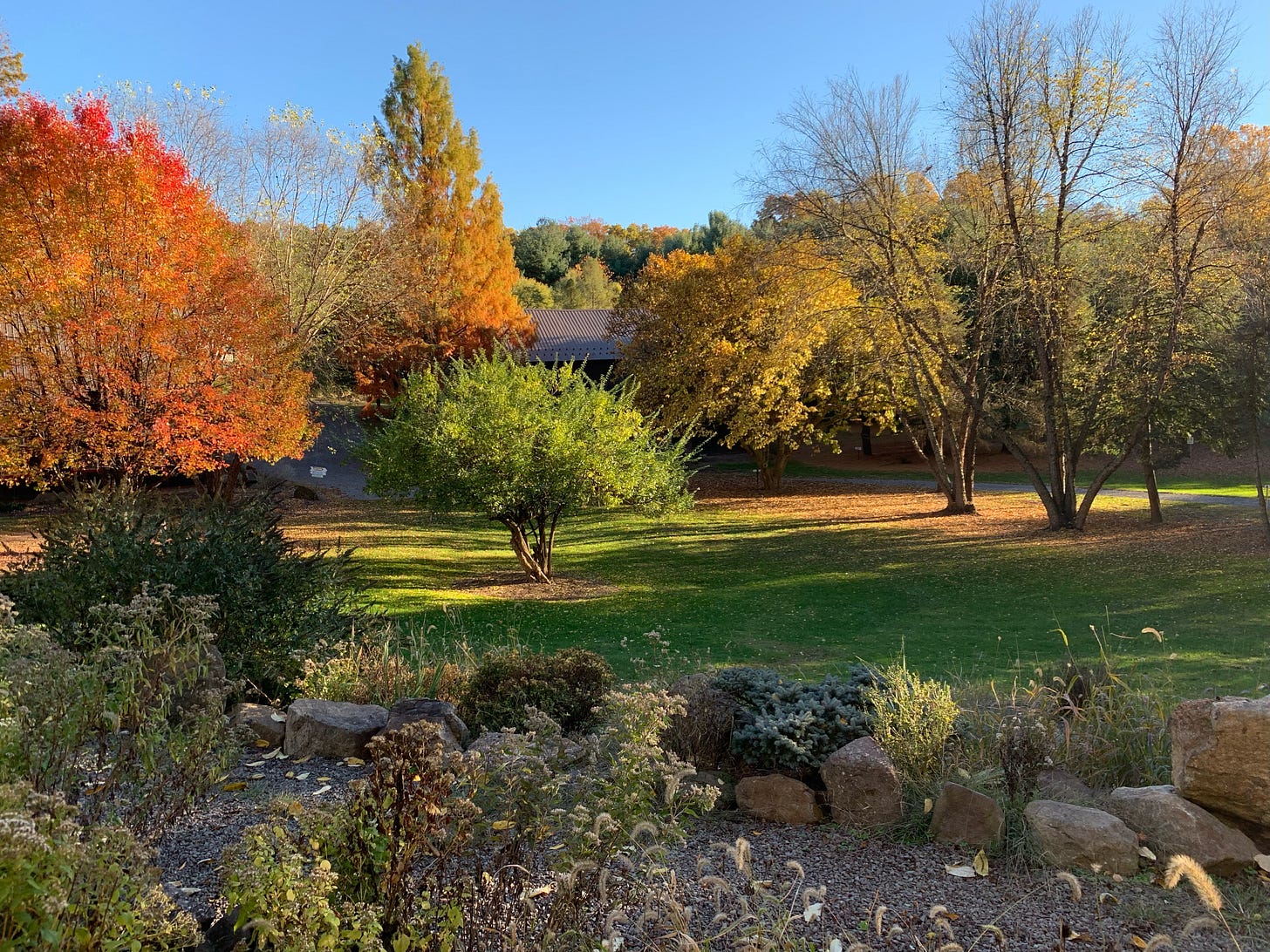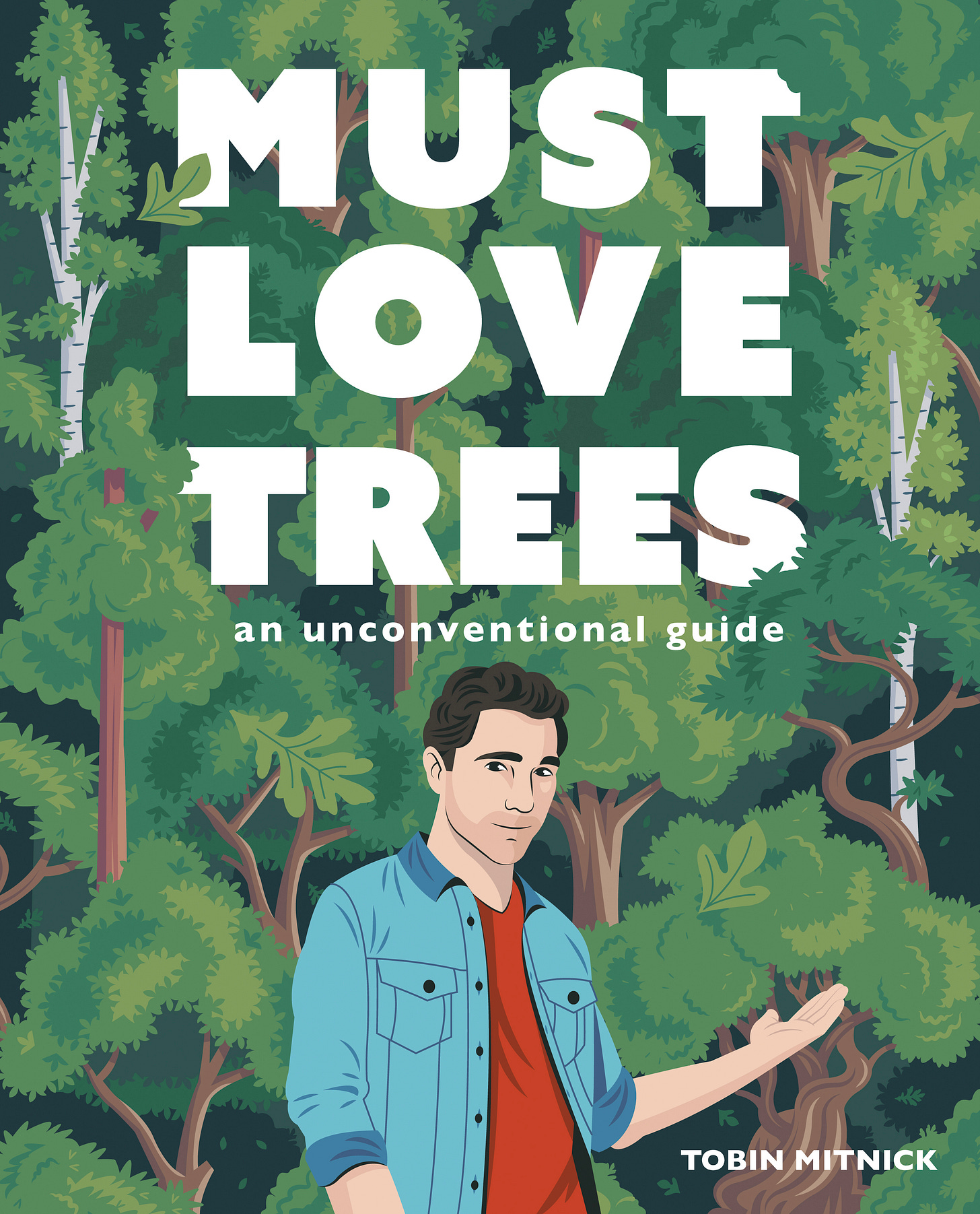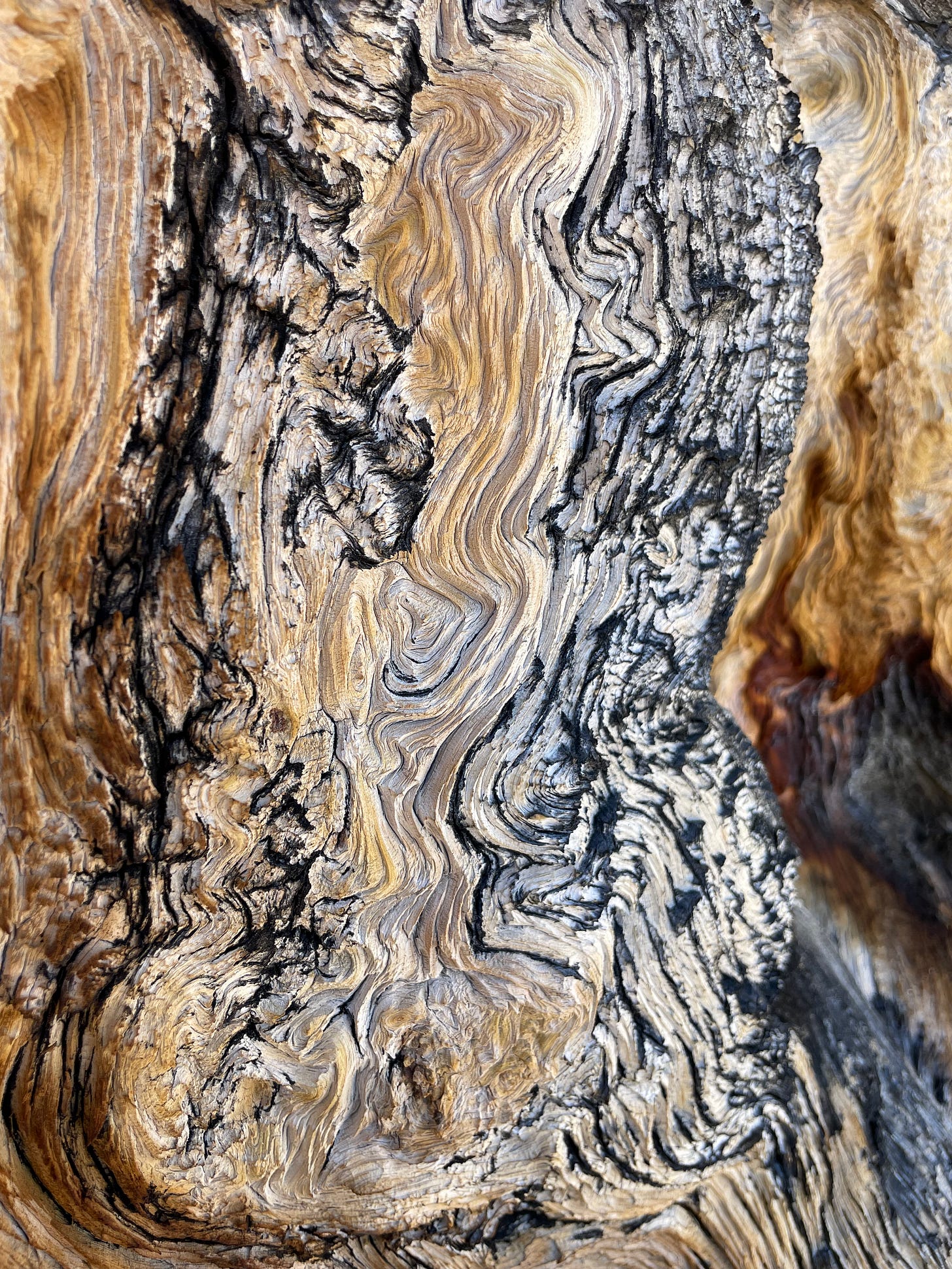Welcome to the Inaugural Issue of the JewsLoveTrees Newsletter
Here you will find three sections: Trees Past, Trees Present, Trees Future.
That should be self-explanatory enough, but sometimes I’ll stretch those terms slightly, like when I include a tree within the corner of a frame of an otherwise non-tree-centric sketch on social media and say that it’s a sketch about trees.
This newsletter will be a mix of tree observation, personal history, and gripes. It also exists partially to promote my book, Must Love Trees: An Unconventional Guide, which comes out in April, so there will also be a new, out-of-context sentence from the book in this newsletter with a list of places to pre-order. If you haven’t preordered it, do! You’ll love it. Also, pre-orders set the demand for the rest of the book’s publication run—essential stuff, bubs! Will also throw in some things I’m thinking about and reading at the end.
Trees Past: The Tree That Wronged My Family
I’m currently in the heaviest week of my autumn marathon training, which is a thing I like to do to add structure into my life like I’m an eight year-old child of divorce. I’m having a great training cycle, meaning the easy days are staying fun and I feel ready and fast on the hard days and long runs. But I think it’s getting to me: I’ve had a series of tremendously irritating on-and-off headaches for the past week-and-a-half, and, though my well-documented health anxiety would tell me this is certain death, it’s very clearly tension wrought by a combination of toddler hoisting, unnatural amounts of exercise, and classic self-sabotage. Nevertheless, it makes me think that something isn’t right inside my skull. And when I think that something isn’t right inside my skull, I always think about brain damage. And when I think about brain damage, I always think about my Nana. And when I think about my Nana, I always think about the Tree That Wronged My Family.
My mother’s mother, Germaine “Joan” Stambaugh, who passed in 1992, had a splintered childhood. She grew up the child of hardy John Stoner of Harrisburg, PA, and Katherine Devlin, an Irish-American who used to dance on tables in neighboring Reading. Needless to say, Katherine did not like the living arrangement with John’s parents, who my mother has characterized through texts as “creepy”. Katherine Devlin left John Stoner and returned to Reading with Joan. She worked, danced on bars some more, and oft foisted Joan onto pals Flossie and Georgie, who had a little bungalow near Friendly’s on Park Road. Apparently Katherine “was always showing up with a different guy in a fancy car.” Joan was caught in the middle of all this meshugas, and she found different ways to pass the time.
In Flossie’s front yard, there grew a tree. My mother and I have tried to divine the species of this notorious tree for years now, juxtaposing recollected features such as low-hanging branches that were easy to climb and the common trees in the area circa 1936, which is when the central event of this story takes place. I’ve often imagined it to be an elm (possible) or a chestnut (unlikely, most were dead by then in PA) in a truly anemoiac sense, which means nostalgia for a time you yourself have never experienced. In looking up the spelling of that word, I also discovered that it has an ancient Greek root meaning when a tree is so wind-blown that it appears to bend backwards. Cool. But these are all bullshit musings on my part, because the tree in Flossie’s front yard was probably a boring-ass apple tree (“genus Malus”, as we tree nerds like to point out) which kids like to climb because they’re really climbable.
Kids like Joan, who, one day in Summer, 1936, scaled the Mystery Tree in Flossie’s front yard then plunged to the ground headfirst. No knowledge has come down to us of who she was with, who witnessed it, or whether the tree let out a groan of remorse.
The only evidence we have at all, in fact, that that day actually happened is in my mother’s leg of lamb, which is sufficient proof that we can broil up hell if we so choose.
Let me expand. When Joan hit the ground, something went haywire in the white matter of her brain. Whether it was her olfactory bulb that violently compressed or something else we’ll never know, because back then it seemed that it was simply a matter of a kid falling chaotically to the ground from a moderate height and completely losing her sense of taste and smell. Happened all the time. I have to say, I always thought this compartmentalization of injury—no other discernible health impacts, just the loss of smell and taste—was tough to buy until I saw H.W. lose his hearing from the same type of injury in “There Will Be Blood”. I yielded to reason completely.
But the brain trauma that Joan sustained in 1936 pales in comparison to the intergenerational trauma that is on-going today. Joan grew up, grew beautiful, married, and had two children, one of whom was my mother. She became the perfect picture of the 1950s housewife. I have seen this picture, and, despite her being 32 (three years younger than me), she looks ten years older than me. The fifties sucked. I have no anemoia for this period.
And neither do I have any for her cooking, which was legendarily bad due to her inability to taste and smell her way to deliciousness. Joan would cook in ways that made no humanly sense. Quoth my mother, whose crystalline memories of inedible dinners still haunt her, “She put sugar on plain rice and on canned corn…particularly bad was her goulash…even the thought of it makes me shudder to this day.” Spine-tingling.
My mom strove to break free of the curse with limited success. But she was strategic. It may have been too much to ask to develop culinary “skill” having been so handicapped for so long eating tuna-noodle casserole dusted with strawberry jello mix, so she wisely put all her sugar-sprinkled eggs into three few baskets: chicken soup, curried meat pie, and lemon chicken. This was all there ever was for me in my mother’s household, but damned if the woman didn’t know how to cut her losses.
Only now with some kind of hubris-driven confidence in the use of olive oil am I beginning to reclaim what was lost on the ground near Friendly’s on Park Road, when a tree we will never know dropped my grandmother Joan like a baby in the Nile.
Trees Present: White Birch Mania
My wife and I, as well as my daughter (yes, even her) just upsized because we’re having another baby in the spring (current due date spring equinox, hell yeah) and we need another bedroom if we don’t want to put our infant and two year-old in bunkbeds just yet, which I have heard from parenting experts is called a “Tobin, that’s really not funny, don’t joke about that.”
Anywho, my old neighborhood, the Hollywood Dell, kind of reminded me of the Upper West Side of Los Angeles: always some crusty old Jewish people who looked like me in fifty years butting their heads into your business. But my new neighborhood is a bit more sterile, kind of like the Upper East Side. Everyone minds his business and nobody interacts. I’m completely fine with that because I get my energy from trees and black-and-white monster movies, but I feel like it’s not for everybody.
The average income in this neighborhood, which is north of Studio City, also seems much higher than the Hollywood Dell, which was already high to start off with. Lots more gates, lots more Porsches and Teslas, lots more landscaping.
And lots more white birches. White birches are the undisputed green wealth signifiers of Los Angeles. Betula pendula, the European White Birch, is one of the only birch trees which stands a chance in Zone 9 or Zone 10, and, even then, it’s an uphill climb without constant attention, moisture, and strategic shade. But that doesn’t stop people from engaging in a “violent, irrational love” for the White Birch, as the legendary Southern California gardener Pat Welsh has described it.
I, too, feel this pull. Whether it’s because of my Russian heritage or some subconscious yearning for the birch forests of the Northeast that I walked through unattentively in my youth, I can’t say. But I can absolutely relate to the impulse to possess one. I’ve very much wanted to buy and plant and tend to a birch of my own— then run my fingers down its powdery cracked bark like Chekhov thinking up his sixth great play (yes, Ivanov is great—fight me)—since I got tree-pilled.
Which is why I was bummed when, after complimenting a new neighbor on the rather crispy white birch in his front yard, he said, “oh, you mean, that? I think it’s dying.” Which was obvious, of course, but I was hoping he’d express some sort of fondness for it or disappointment regarding its demise or even know what type of tree it is. “That”—good God, man, it’s a Betula pendula for Chrissakes!
But it’s not his problem. It’s easy to infer that white birch is a go-to tree for folks who simply want their landscaping to feel fancy. When I do my regular, suicidal, drive-through-the-hills-to-avoid-Cahuenga route, I inevitably spot white birches of varying health in front of the richest houses. It’s clear that there’s a school of thought amongst up-scale landscapers that white birch connotes wealth, even though they need a great deal of care to thrive amidst month-long heat waves and 25% humidity. You know, like the English Nobles who used to import exotic animals then were surprised that the crocodiles died “without water”?
The end result is a great deal of Betula pendula hanging on by the skin of their leaf serrations and gummying up even the most manicured front yards with a bunch of stringy, leafless branches and top-chopped trunks that some tree-trimmer thought would fix the problem.
You can definitely laugh if you want, it’s pretty funny: some wealthy folks don’t know how to care for or don’t care to take care of a fragile tree, then give up caring because they’re probably caught between exhaustion at the idea of bringing it back to health, guilt at the idea of chopping it down, and frustration that its spoiling their yard.
But I really wish all these white birches, only a handful of which are placed just right, watered just right, and pruned just enough, were all full and green and beautiful because everyone who chose to plant one had done it out of a violent, irrational love that didn’t fade away like some kind a high school crush.
Trees Future: Thanksgiving Tree Walks
Next week, a good deal of us will travel and observe a shift in the biome. This could well be dramatic. For example, I’ll be traveling to Philadelphia from Los Angeles, and my landscape will shift from lamentable palms, occasionally pleasing tropicals, and heat- and drought-tolerant broadleaf evergreens and conifers to mostly temperate deciduous trees like Maples and Oaks and some cold-loving conifers, like spruces. A dream come true. A five-day tree vacation.
Or your biome shift could be barely perceptible at a friend’s house across town.
Regardless, you’ll probably be eating and drinking more than usual and spending time with people you at the very least can deal with, so I would recommend building in some digestion-based tree walks.
I know that I’ll be refamiliarizing myself with the trees I like the most at home and on the east coast, and I’ll also be looking for new ones that I only have a few days to find then think about for a few months afterward like the sense memory of reading a favorite book for the first time
If your travel is local, say maybe across your city, it can still be rewarding to bully your family and friends into a tree walk where you lecture them on why specific trees occupy specific spaces (for example, the in-built connotation of affluence of white birch which we discussed earlier, or perhaps the aristocratic heritage of the Deodar Cedar, which currently dots the lawns in front of Wilsonian houses on Los Feliz Boulevard in Los Angeles —an early attempt to re-create the vibe of prosperous English country homes, many of which feature a large, old true cedar on the front lawn.)
Regardless, bring a field guide with you for these digestion walks, and email your friends and family now to give them fair warning. I recommend the following incentives to entice the tree-skeptics: “the walk will be limited to thirty minutes,” “I have a pocketful of Werther’s Originals and I just may give them out to whomever finds me a Pin Oak,” “I have it on good authority that one of these trees harbors eleven troy ounces of gold inside of it. Good authority, nor perfect.”
An Out-of-Context Sentence from Must Love Trees: An Unconventional Guide
Page 48:
“If you can trust her not to tell anyone that you cried when you found out that you were cast as Lefou instead of Gaston in the seventh-grade Spring Swing, you can trust her with anything.”
Pre-order from:
Things I’m thinking about and reading:
-This unbelievable birch bonsai by Sergio Cuan. Every so often a bonsai tree passes from “incredibly cool” to “moving” in my mind, and this is that rare tree.
-Brothers (& Me): A Memoir of Loving and Giving by Donna Britt, a Washington Post columnist. I have spent so much time thinking about myself and my lot (I include trees in this) that I forgot the power of a deep personal memoir.
-My trip to the White Mountains to seek out Methuselah, the oldest tree in the world, with Justin Davies. Using clues from other tree people, along with our deep knowledge of relative positioning (what?), we found her. It was an electric moment, knowing that we were standing alone with a tree that has accumulated so much psychic power over the years simply from the meditations of millions of people around the world. But the tree itself was plain, relatively unimpressive, and barely hinting at the fact that she’d lived 5,000 years between a couple of rocks. We made our way up to the Patriarch Grove later, where 3,000 year-old trees stand one hundred feet apart from each other, while the in-between space is filled with saplings and adolescents, barely a day over 100. I cried twice. A day one does not easily forget:








10/10
Toby!
In our first house in Reading, guess what tree we planted in 1979, smack in the middle of the front yard??? Yep! A white birch!